Don’t live in New York City or Silicon Valley? Uncomfortable talking about yourself? Shudder at the thought of asking strangers for favors? You’re not alone.
A research study examining the effects of building instrumental ties found that networking to advance ourselves professionally makes us feel “dirty”.
“Before I tapped into virtual networking, my circles were limited to where I lived,” says Laurel Farrer, an internationally renowned management consultant who helps traditional corporations transition to remote work. All from her home office in rural Connecticut. “I also have social anxiety, and I'm very introverted. So going to cocktail parties, and BNI groups, and whatever, that is my living nightmare. I hate pitching people.”
Luckily for most of us, professional networking is changing in ways that level the playing field for those who live outside of major metropolitan areas and find networking events uncomfortable. Virtual networking opens up a world of expertise and opportunities. It also lends itself to the kinds of deep one-to-one conversations and genuine connections introverts excel at.
The problem is, the same technology that makes it easy for you to reach out makes it easy for everyone else to reach out too. How do you stand out in crowded inboxes and noisy timelines?
The great paradox of virtual networking is that the people most likely to reach out are the least concerned about imposing on others, and the people worried about being too pushy never reach out at all. Far from making networking less personal, digital platforms reward those who take the time to make networking more human.
If you feel weird about reaching out to someone who doesn’t know you and asking for their time, you already have the right instincts to stand out.
This guide will give you the concrete steps to channel those instincts into a digital networking approach that’s both genuine and strategic. We’ll also sprinkle in advice and real-life examples from virtual super-connectors like Laurel who have built meaningful professional relationships one message, email, tweet, or virtual coffee at a time. You’ll walk away with clarity on how to define your networking “why”, tips for pinpointing the ideal people to connect with, and our best advice on how to get (and give) value while building your newfound network.
Before you start networking
Most people skip these steps and jump right to making connections. But taking a couple of hours at the start to get clear on why you’re networking and the value you can provide to the people you want to connect with will save you—and the people you’re reaching out to—a lot of time.
Get clear on why you’re networking in the first place
If you’re networking, it’s because you want something. That’s ok! This is how networking works. Being upfront about what you’re looking for isn’t rude—wasting people’s time is rude. Before you do anything else, get clear on what your goals are for networking so you’re connecting with the right people and asking them the right questions.
“Articulate what your objectives are for networking, and define success metrics. Why am I reaching out? What does value mean to me?,” Laurel recommends. “It's going to be different for everybody. If I spend a half hour with somebody that's not going to be a lead for my business, was that an hour wasted or an hour well spent?”
Here are some reasons people network beyond “it’s what everyone says you should do”:
- Find a job in X field or at Y company
- Find clients in ABC industry or who care about XYZ topics
- Find reliable freelancers
- Discover future talent for hiring
- Connect with industry peers to learn from their experience, get referrals, or just commiserate
- Decide which career to pursue
- Cultivate sources and leads for news stories
- Find a co-founder
- Find investors who share my vision to [insert company mission here]
- Find mentors who will advise me on my next career steps
This step can feel intimidating, transactional, and even counterproductive. If you’re just starting out and your objective is “find a job that pays me money”, narrowing your focus can feel like cutting yourself off from opportunities. But without a filter for who you want to connect with and why, you’ll end wasting a lot of time—yours and others.
You can have a clearly defined objective to focus your networking efforts and inform your outreach strategy while still being open to unexpected opportunities. And remember, your goals now might not be your goals in 12 months or even 6 months. Your objectives for networking will change over time as you gain knowledge and experience, so don’t worry about boxing yourself into one thing. Continue refining your networking goals over time.
Only after you’ve figured out why, decide who
Once you know why you’re networking, you can start building a profile of who you should be connecting with. Build out 1-3 target personas of people you want to meet with the criteria that is important to you, for example:
- Job titles that you’re drawn to
- Industries that you’re interested in
- The size and type of company you’d like to work for (e.g., start-up vs. an established brand, VC-backed vs. bootstrapped, agency vs. in-house)
- Specific companies you’d like to work for
- Specific managers you’d like to work for
Not sure where to start? You probably have a better idea of who you should be connecting with than you think.
“There's so much that we do intuitively or organically. If we just sit down and give it some thought, we find that we actually have thought through who we want to connect with,” Laurel says. “We just haven't ever taken the time to organize and write it down. Do a little market development plan for yourself. What are your target profiles? Hone in on a few keywords you want to search for.”
Pay attention to what sparks your curiosity and look for patterns. What job descriptions captivate you? What companies draw you in? Whose work do you admire? Why? Professional jealousy is a great indicator of who you should be connecting with. The people whose work or careers you want to emulate are the most likely to have relevant experience and advice.
Connecting with someone who’s just a step or two ahead of you in their career—rather than decades further along—can be a great source of knowledge and opportunities. These people have just gone through what you’re going through and often have more detailed and up-to-date advice to give. They’re time is also less likely to be in demand, making them more likely to respond. They may not be in charge of hiring, but they can put in a good word.
Ask new connections if there’s anyone in their network they think you should connect with, and ask if they’d be willing to make an introduction. A warm introduction through a mutual connection will always have a higher rate of success.
Keep in mind that the more “important” the person is, the harder it will be to connect with them. They’re busy and inundated with requests. That doesn’t mean you shouldn’t reach out, but if they turn down your request or you don’t hear back, don’t get discouraged. Just because someone doesn’t respond the first time you reach out doesn’t mean you won’t be able to connect with them later on in your career.
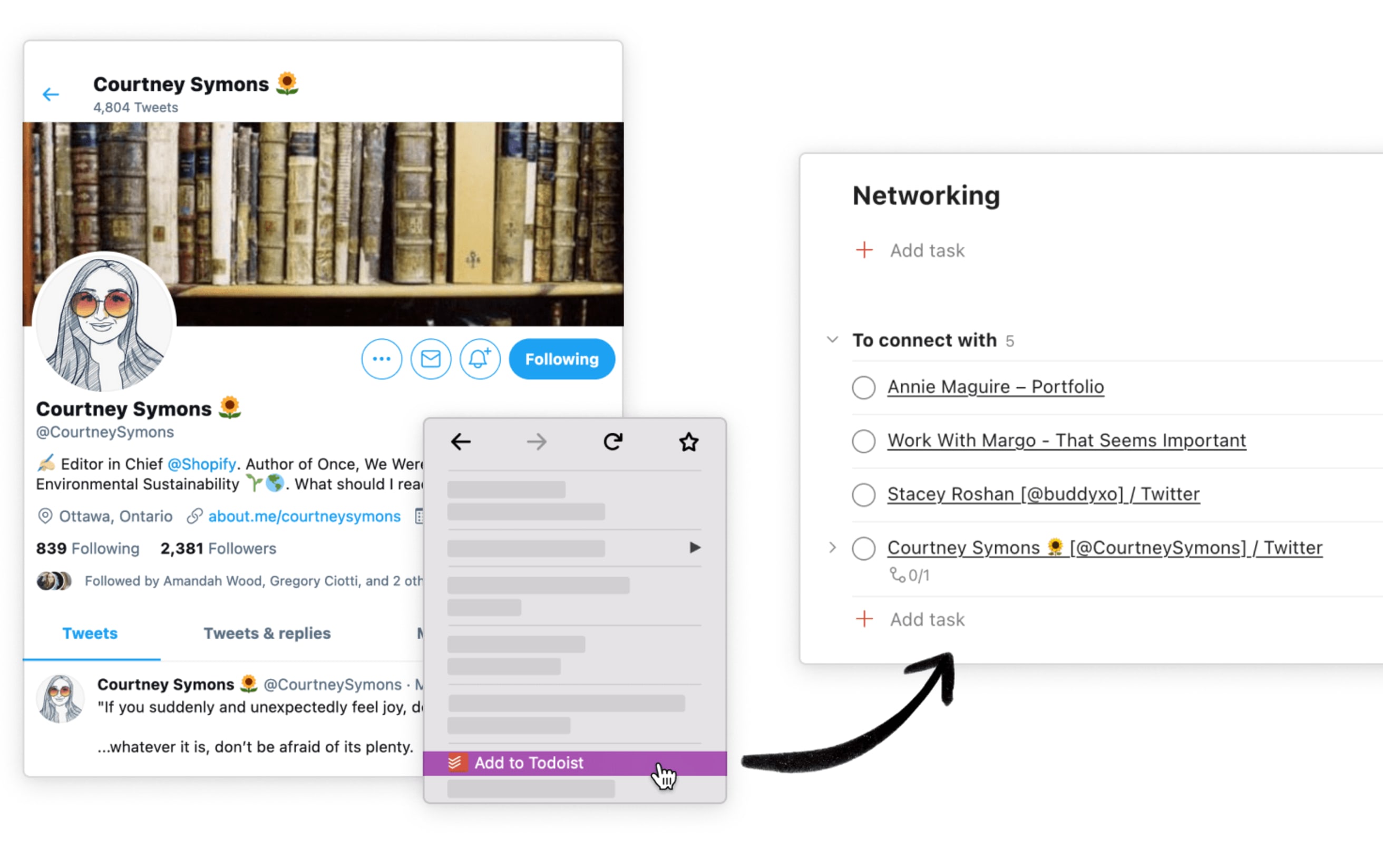
[caption id="attachment_8459" align="aligncenter" width="1472"]Have a system for keeping track of who you want to network with. I use the Todoist web browser extension to save profiles to my Networking project to come back to later.[/caption]
Get clear on the value you provide and get comfortable communicating it
Skipping this step was the biggest mistake Laurel made that held her back from taking full advantage of her network.
“Everybody knew who I was, but nobody knew what I did. I'm very humble and I don’t like being pitched myself,” says Laurel. “I wanted to come off as genuine, not salesy, but I took that to an extreme. I probably missed out on a lot of lead opportunities, because people were like, ‘Oh yeah, I wonder if there's somebody that could help you with that.’ And I was like, ‘Hi, I can. That's what I do.’”
Be sure you can tell a simple story about who you are, what you do, and the value you can provide. No need to over-complicate it. Here are a few examples:
- I’m a management consultant who helps big corporations make the shift to remote work.
- I’m a design student looking for a junior product design role at a mid-size SaaS company that values good UI/UX design.
- I’m a content marketer looking to learn from the experiences of other content marketers and share mine in return
You can have all of the connections in the world, but if they don’t know your story, what you’re looking to accomplish, and the value you can provide, they won’t be able to help you. And if they’ve taken the time to talk to you, they want to help you.
Building connections from scratch
Technology has made it easier than ever to connect with anyone in the world. For better and worse. Everyone’s LinkedIn InMail and email inboxes are filled with generic templated emails and irrelevant requests:
[table id=2 /]
Luckily, that means it’s easy for you to stand out from the noise.
Approach networking with a generous mindset
Most people think of networking as asking people for something. In truth, great networkers spend more time thinking about what they can give than what they can take. All relationships are built on reciprocity; professional networking isn’t different.
“Always be asking yourself what you can do for the other person,” says Laurel. “That really builds a relationship of trust and makes you memorable.”
Here are some examples of ways you can network generously:
- Connect others to job listings or freelance opportunities—when you help a great candidate find a great company you’re doing both sides a favor
- Recommend them for a panel or a source for an article
- Contribute to open source communities
- Share free design templates or tools for apps like Figma and Procreate
- Share your experience when they ask a question on social media
- Amplify their work and social media posts
- Make introductions to others’ in your network
- Feature them in a blog post you’re writing or podcast you host
- Send them an article, book, video, or other resource you know they’d find interesting or helpful
- Let them know the impact they’ve had on you—it makes people feel good to know they’ve helped someone
[caption id="attachment_8473" align="alignnone" width="3024"]
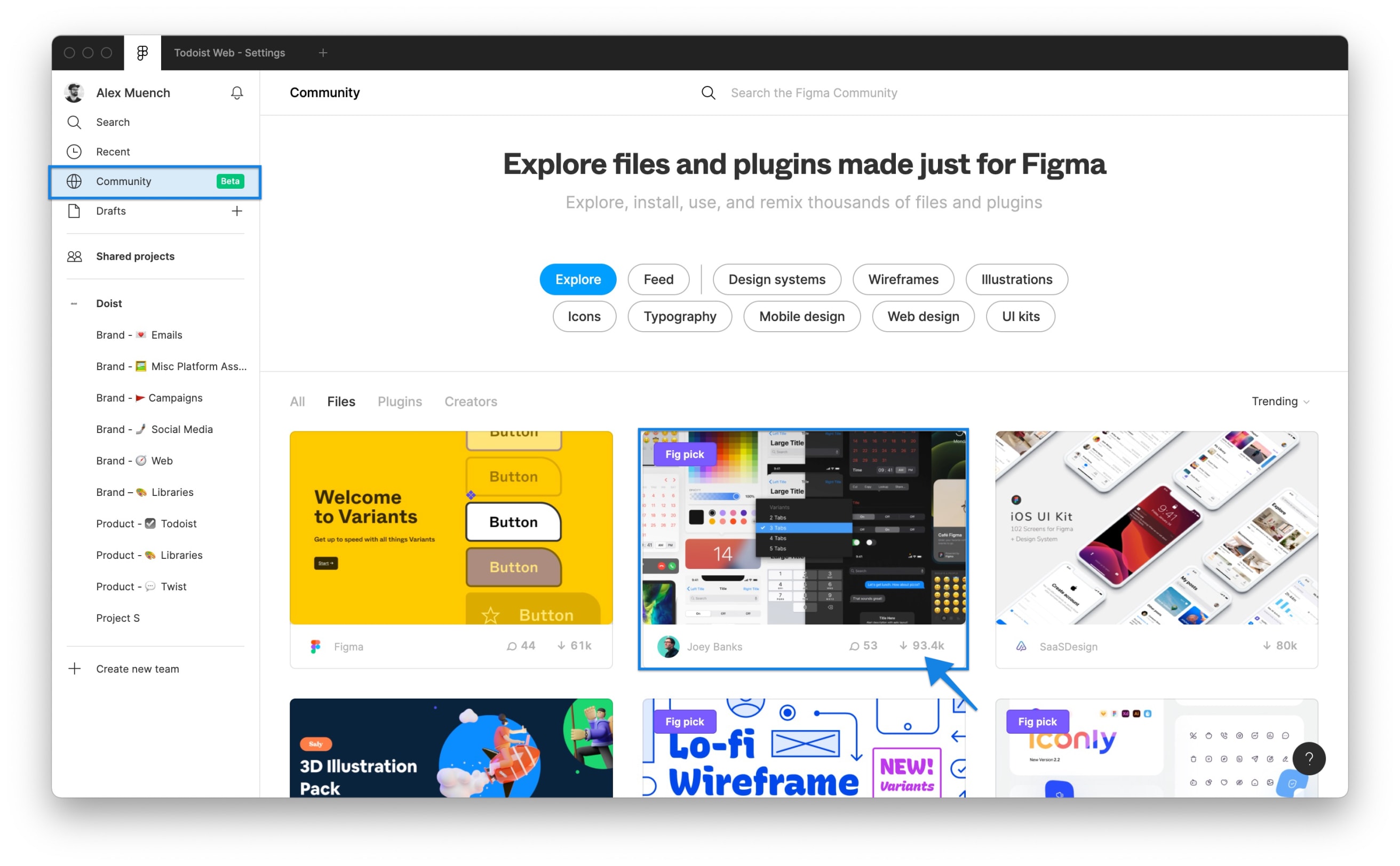
Contributing design templates to the Figma community is a great way for designers to network generously.[/caption]
It may not be obvious how you can help the other person when you first reach out. That’s ok. There are still non-spammy ways to reach out and make a connection without something to offer up front. But from first making a connection to continuing the relationship, always be thinking about what you can give, not just what you can take.
Use a mix of inbound and outbound networking
Targeted outreach is great, but every connection takes a lot of time and effort to create. It’s a lot easier when the right people are also finding you. Cast a wider net with a two-pronged approach of active networking, reaching out your targeted list, and passive networking, creating content that people find organically.
This type of organic “inbound” networking might take a more structured form like a blog, a personal newsletter, publishing on Medium, posting your designs on Dribbble, or contributing to an open source community. Or it might be more informal—actively sharing helpful insights on Twitter, or participating in discussions on a community forum.
It’s also a lot easier to reach out to someone when they’ve already seen you on Twitter or read an article you wrote.
Yes, it can feel like you’re shouting into the void, especially at first. But you don’t have to reach thousands or even hundreds of people to make valuable connections. And you’ll have a digital presence to make you more “legit” in the eyes of the people you’re actively reaching out to. Periodically popping up on people’s social media timelines also keeps you top of mind after you’ve made an initial connection.
"Some might think 'Oh, this has been talked about previously, there are already guides about this topic online, why should I bother?'," says Alex Muench, a senior product designer at Doist. "You should because everyone has their own perspective that people can relate to. My goals with sharing on social media is to inspire and be inspired by others. Anyone can do that!"
Here are some great examples of inbound networking that don't look like networking at all:
OK. SO. Nobody wants to do any actual work today, so here's a thread about what it was like to run my UX research consultancy (@brazenUX) in 2019. I'll talk about... 1⃣ Funnel 2⃣ Hours 3⃣ Financials 4⃣ Goals
I wrote about this "secret homepage" idea here ... kevanlee.substack.com/p/209-your-sec… Thanks to @buffer @polly_ai @PostscriptIO @doist for the inspiration 🙌
Identify where the people you want to meet already are
There’s no single right answer for where you should be networking.
When Laurel started building her network, she often reached out on LinkedIn. I got my job at Doist through a cold email to the COO. Stephen, now a brand designer at Doist, initially connected with Alex on Twitter. [caption id="attachment_8460" align="aligncenter" width="444"]
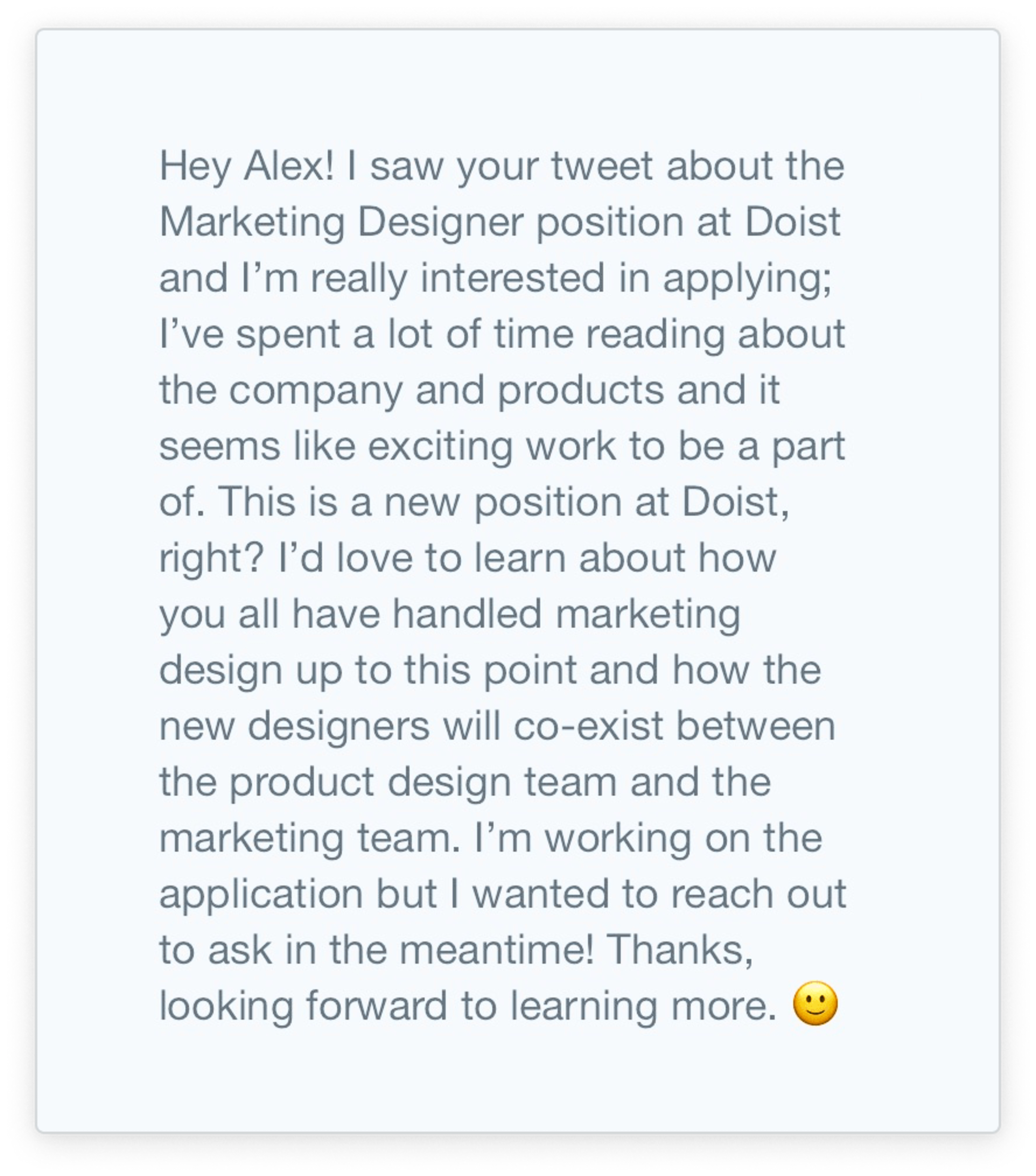
Stephen (now a brand designer at Doist) first connected with Alex via this Twitter DM.[/caption]
Kat Boogaard, a freelancer writer who’s used trial and error in networking to land bylines in publications like the Mashable, Fast Company, and the New York Times’, told me she’s found success with a mix of all three—Twitter, cold emails, and LinkedIn messages—in that order.
Private social networks are another great way to connect with a more targeted group of people. For example, Fadeke connects with other content marketers on the Superpath Slack group. There are more and more professional Slack, Discord, Clubhouse, and Facebook groups cropping up every day for every kind of job title, industry, and interest.
It will probably take some experimentation to find the right venues for connecting with the right people. As with many endeavors in life, networking follows the Pareto Principle—80% of opportunities will come from 20% of your efforts. Instead of trying to be everywhere at once, hone in on the platforms and communities that are most valuable, preferably ones that you actually enjoy contributing to. Opportunities come from long-term investment so limit yourself to the number of communities you can actually engage with and provide value to.
Choosing the right medium to reach out
Even if you’re networking in all the right digital places, it’s not always obvious where you should actually reach out. InMail? Tweet? Twitter DM? Instagram DM? Email? Unfortunately, it depends on the person.
An email introduction from a mutual connection is always your best bet, but if you don't have an existing connection there are ways to make cold outreach warmer. "Simply replying to a tweet or engaging in existing discussions can be a natural first step to building a relationship and making yourself known in a community," says Alex. "Keep your eyes open for people already offering to help."
Cold email outreach done the right way (more on that in the next section) can still be a great way to make a connection, but it's less invasive if the person has already made their email address public. [caption id="attachment_8477" align="alignnone" width="1476"]
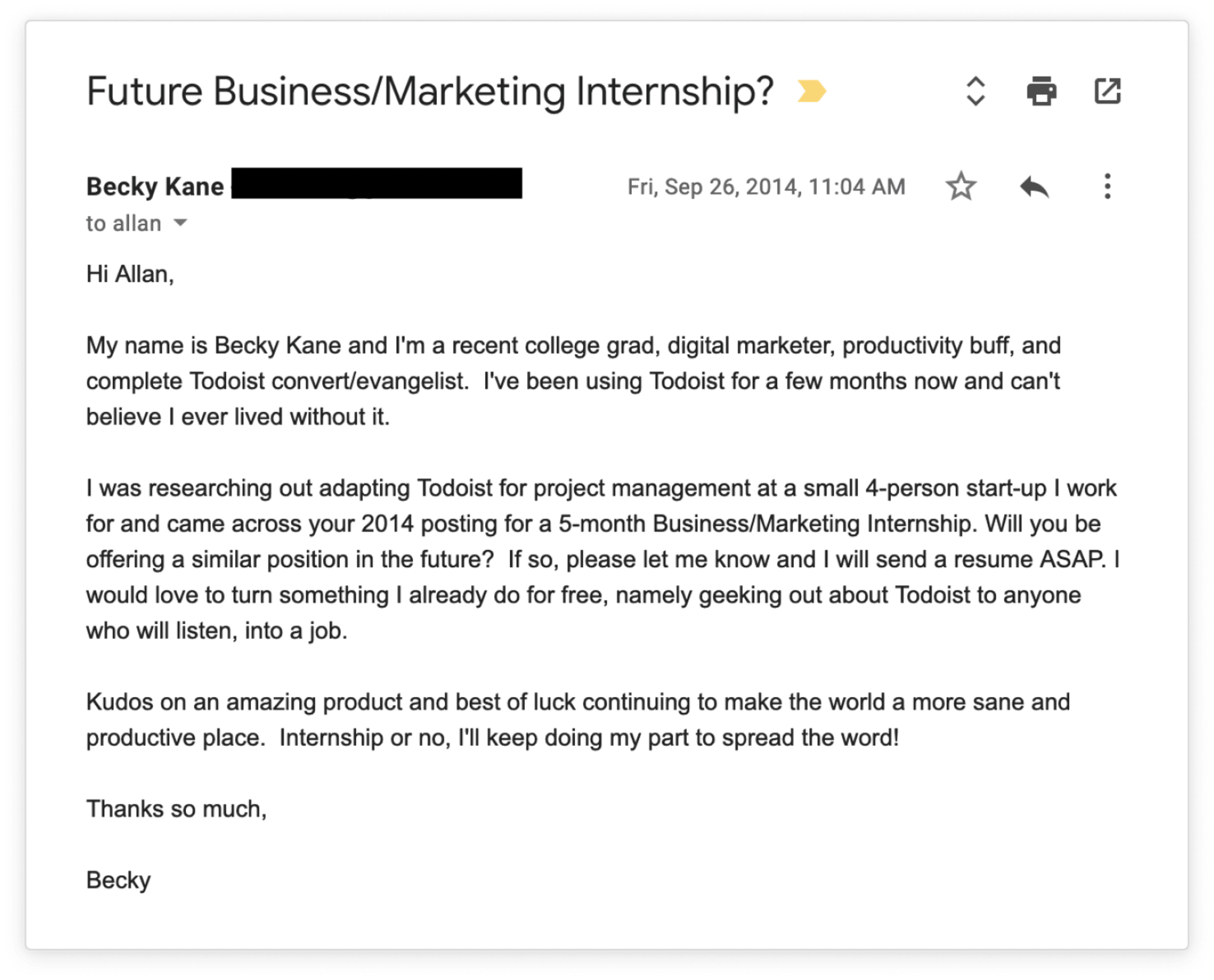
This cold email that lead to my accidental dream job of the past 6 years.[/caption]
If the person has an email newsletter, replying to the newsletter is often a warmer approach than reaching out with no context at all. As a subscriber, you’ve already demonstrated a genuine interest in what they have to say which goes a long way. If you genuinely appreciate the newsletter, take the extra step and share it with your own followers on social media (tagging the person so they see it) before reaching out. [caption id="attachment_8462" align="aligncenter" width="1476"]
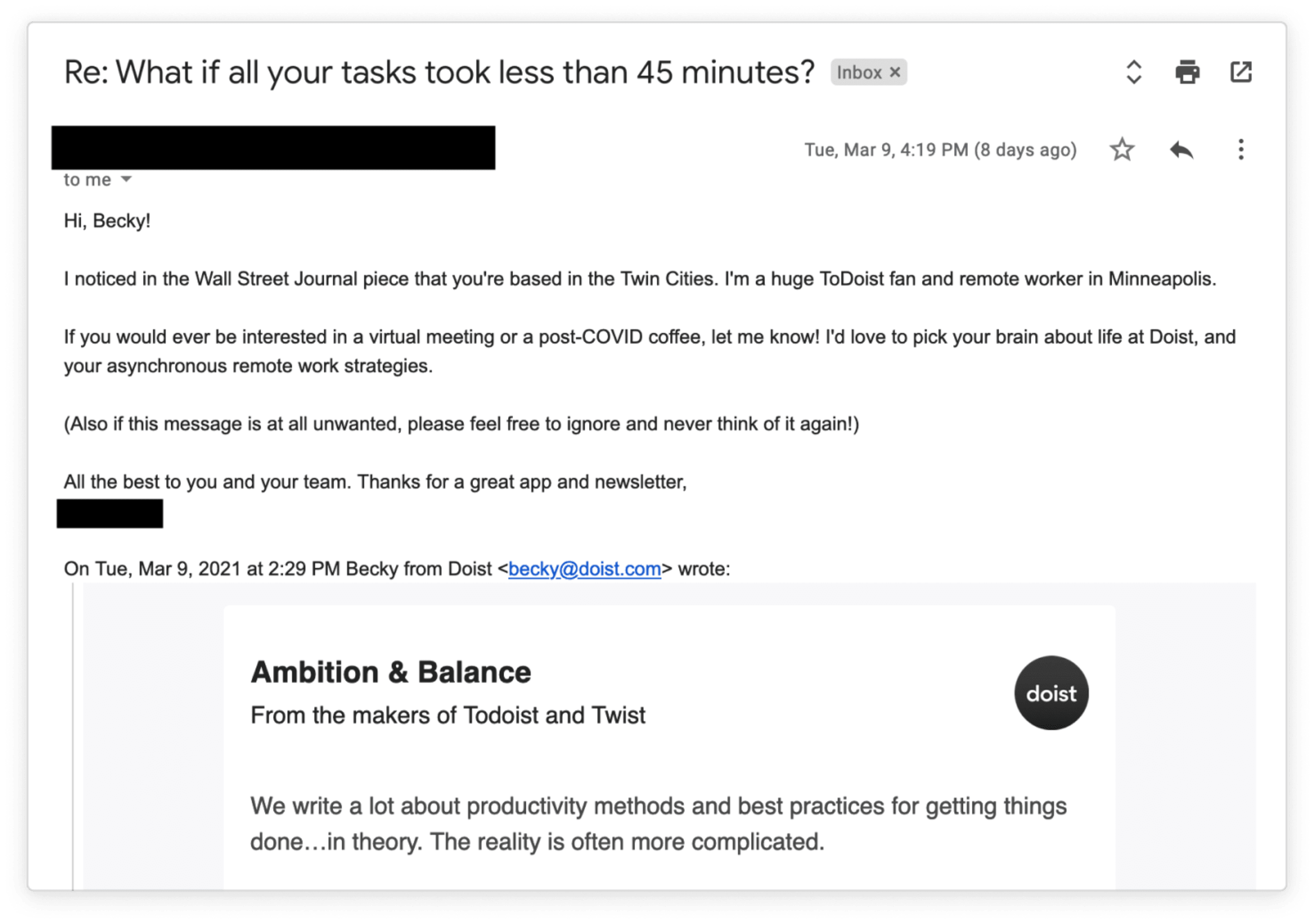
This is a real-life example of a recent reply to the Ambition & Balance newsletter. We’re grabbing a virtual coffee on Thursday.[/caption]
As with finding the right places to network, finding the right platform to reach out on will take some trial and error.
Craft your initial outreach carefully
This is the hardest step to networking. It’s also what will make you stand out in a sea of lazy mediocrity. Take the time to draft a message that accomplishes your goals while still being genuine.
Personalize every outreach. No matter which platform you’re reaching out on, take the extra time to make it human.
“Find something you can connect on,” says Kat. “Maybe you're both training for a marathon. Or you both have goldendoodles. Or you both went to the same college. Whatever it is, find a common thread and lean on it. It makes cold outreach feel a little more warm."
Just be careful not to overdo it. "When people tell you about their whole life story in first two or even three paragraphs, it feels like they're wasting your time," says Alex. "Give enough context and information so they understand where you're coming from, but get to the point as quick as you can."
Expressing appreciation for something the person wrote or said that resonated with you is another great way to personalize your message. Everyone loves to hear that they’ve had a positive impact on another person. Just be sure the appreciation is genuine, not just a way to tick the “personalization” box. Bonus points if you’ve already interacted with the person on social media or shared their work online before you reach out to show you actually follow their work.
The whole point of personalization is that it can’t be templatized, but here are two real-life examples of successful outreach to give you some ideas: [caption id="attachment_8480" align="alignnone" width="738"]

An actual email Kat used to land a new freelance client[/caption] [caption id="attachment_8463" align="aligncenter" width="1472"]

Screenshots via Marketing Examples. Read more about personalizing your outreach with just a couple minutes of work.[/caption]
Include a clear request for them to respond to. They can’t help you if they have no idea what you’re looking for. Asking for advice is a great, non-spammy way to make a connection. Laurel recommends always trying to get on a call if you can. “There’s no replacement for that human spark of face-to-face interaction,” she says. “That’s what makes you memorable.” [caption id="attachment_8464" align="aligncenter" width="1476"]

Another example via the aptly named Marketing Examples. Read more about an advice-based approach to outreach.[/caption]
If you don’t hear back, follow up. It’s not rude or pushy to follow up! Give it two weeks to two months. If you haven’t heard back, reach out to make sure they got your email, message, etc. Waiting longer to follow up can work in your favor. When someone politely follows up two months after the fact, it’s clear they really want to connect and aren’t just going through the motions.
However, there’s a fine line between polite persistence and being invasive. A good rule of thumb: Follow up no more than twice in six months and on no more than two platforms (e.g., email and Twitter DM). You can always reach out again in the future if you have reason to. Sometimes it’s just not a good time for that person for whatever reason. Never burn a bridge by coming off pushy or entitled.
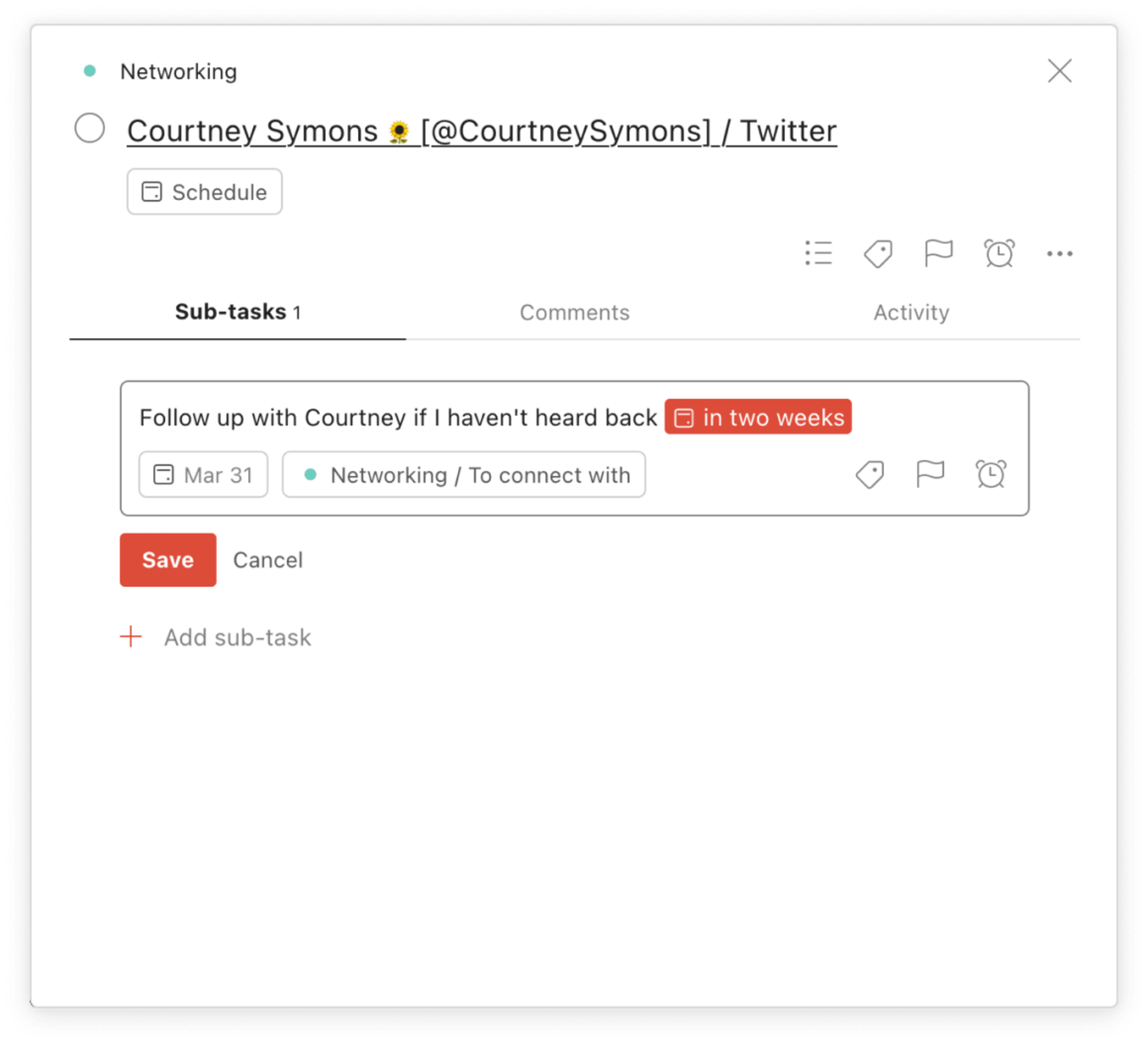
Keep track of your follow-ups in a digital task manager like Todoist so you don't forget.
If you get a call, spend 90% of the time listening
If you asked for the call, you’re responsible for driving the conversation. That doesn’t mean dominating the conversation, but rather coming prepared with the right questions.
Do your research. Google them. Check out their social media profiles. Get familiar with their work. Have a list of questions at the ready to guide the call and to fall back on if there’s a lull in conversation.
Then be ready to listen. A good rule of thumb for any networking call you asked for is to spend at least 90% of the time listening. This is where introverts have a leg up.
“I cannot even tell you how many times I've had to stop people at 25 minutes and be like, "Okay, I'm sorry to interrupt, but we're at 25 minutes. We've got five minutes left. Would you like to know my name or anything about me at all?,” says Laurel.
Follow up with a thank you that keeps the door open
It’s a quaint piece of advice that’s as relevant today as it was a hundred years ago and hopefully will be a hundred years from now. Follow up right away if you can or add a task with a due date and a reminder to follow up the next day.
No one wants to feel like they’ve wasted their time or that you’ve ghosted them, so let them know how much the conversation meant to you. Was there something they said that really made you think or was particularly helpful? Tell them! Are there actions you’re going to take based on their advice? Let them know! Did you commit to doing something—make an introduction, send an article, invite them to an event—do it!
Maintaining connections
Once you’ve put in the work to make a connection, maintain it. When you've invested in a relationship over a long period of time, it's easier for you to reach out and ask for help and it's more likely that they'll say yes.
“At its core, networking is about building relationships,” says Kat. “Sure, you might have another goal in mind—landing a job, securing a new client, scheduling an informational interview, etc. But, none of that happens without the relationship first. I've built relationships that didn't offer any quantifiable 'pay off' until months or years later. This isn't a quick win.”
Here are a few ways to nurture the connections you want to stay strong:
Follow up once or twice a year
You won’t be able to maintain relationships with everyone you connect with, but be sure to reconnect periodically with the people you do want to stay in touch with. It doesn’t have to be something they need to respond to—just a genuine update.
- Send a link to something that made you think of them
- Highlight something they wrote recently that you appreciated
- Recommend a product you’ve found that you think they’d find helpful or a company or conference you think they’d find interesting
- Give them an update on your career—if someone’s advice and an introduction they made helped you out, tell them!
[caption id="attachment_8466" align="aligncenter" width="1476"]

A real email I received from Jeremey DuVall, a freelance writer I’ve worked with in the past. I was delighted.[/caption]
Don’t overthink things. When it comes to maintaining relationships, follow the two-minute rule: When you have a nice thought about someone or something reminds you of them, just take the two minutes to send them a quick email or a DM.
“People tend to have this really formal, buttoned-up vision of what 'networking' is. But, it doesn't need to be that stiff,” says Kat. “Did you reply to someone's tweet? Congratulate them on their promotion on LinkedIn? That's networking.” [caption id="attachment_8479" align="aligncenter" width="305"]

Send a quick update a few months later letting them know how their advice helped.[/caption]
Create a system for nurturing relationships
Following the two-minute rule doesn’t mean leaving your relationships to chance. Networking usually falls into that important but not urgent category of task that’s the easiest to put off for later. Create a system to keep track of who you want to connect (or re-connect) with when so those relationships don’t fall off your radar.
“I keep a list of my go-to people in my network,” says Laurel. “That's a different list than LinkedIn or people I follow on Twitter in general. So I've got the list of people who are important to me. I want to nurture those relationships. Maybe once or twice a year, I'll just go through the list and make sure that I just touch base in one way or another.”
Unless you work in high-volume sales, you don’t need a complicated Customer Relationships Management (CRM) tool to keep track of your relationships. Here’s an example of a simple CRM system you can build with Todoist:
- Keep a “Networking” project in Todoist where you keep a list of the people you want to keep in touch with. (You can also keep a list of people you want to connect with in the future here.)
[caption id="attachment_8467" align="aligncenter" width="1476"]
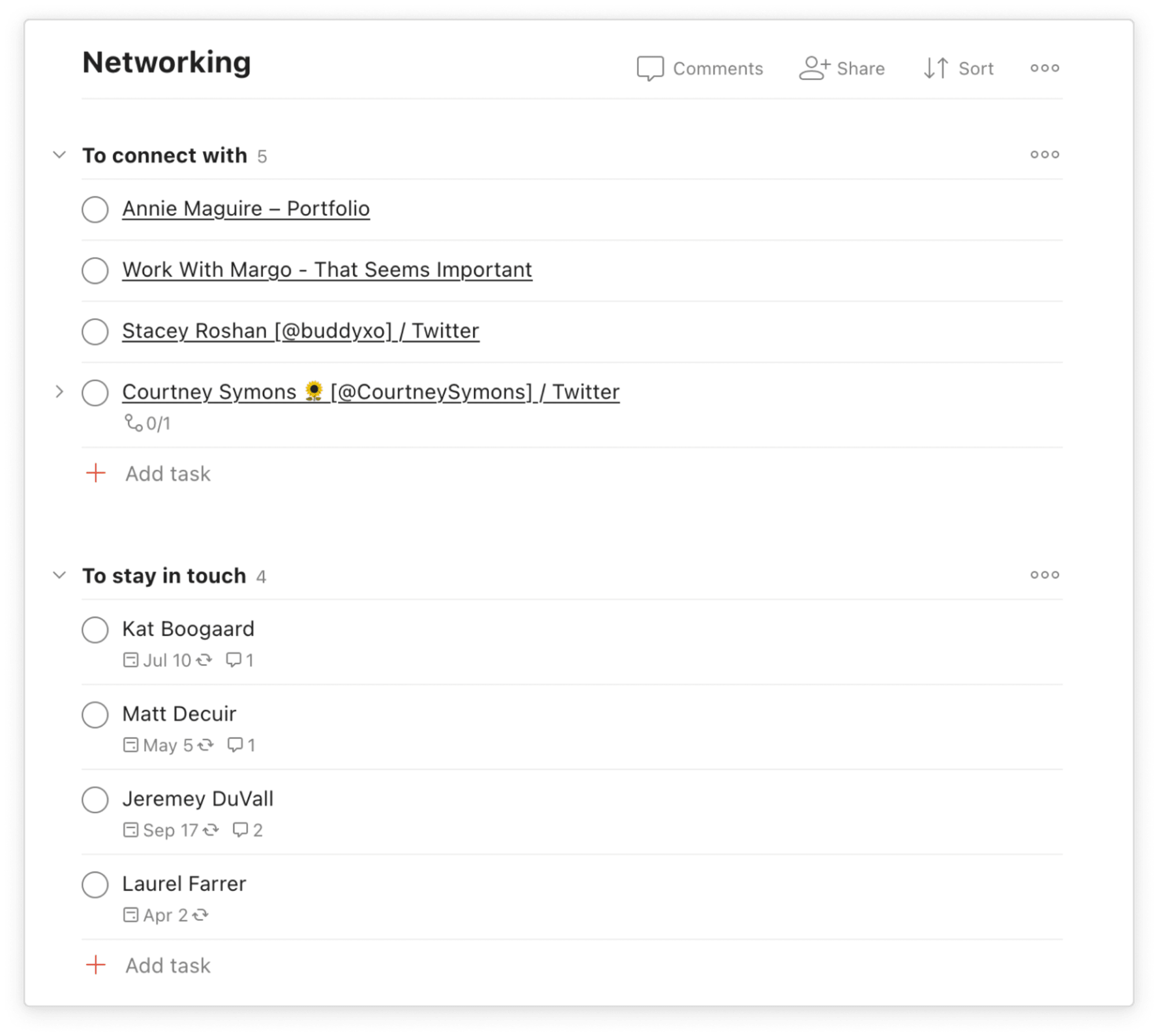
Create a new Networking project with sections for who you want to connect with and who you want to stay in touch with.[/caption]
- Whenever you reach out to someone, add a task to follow up two weeks to two months later if you haven’t heard back. If you use Gmail or Outlook, you can use Todoist’s email plugins to save the emails as tasks with a link back to your original outreach.
- Once you make a connection, add a task with a recurring due date—for example, every six months—to remind yourself to stay in touch. Those tasks will pop up on your to-do list at the right time and will automatically reset when you complete them so you won’t forget.

Use recurring due dates to make sure you're maintaining your professional relationships.[/caption]
- Add details you want to remember about people in task comments. You can even forward emails to comments to keep track of past correspondence.
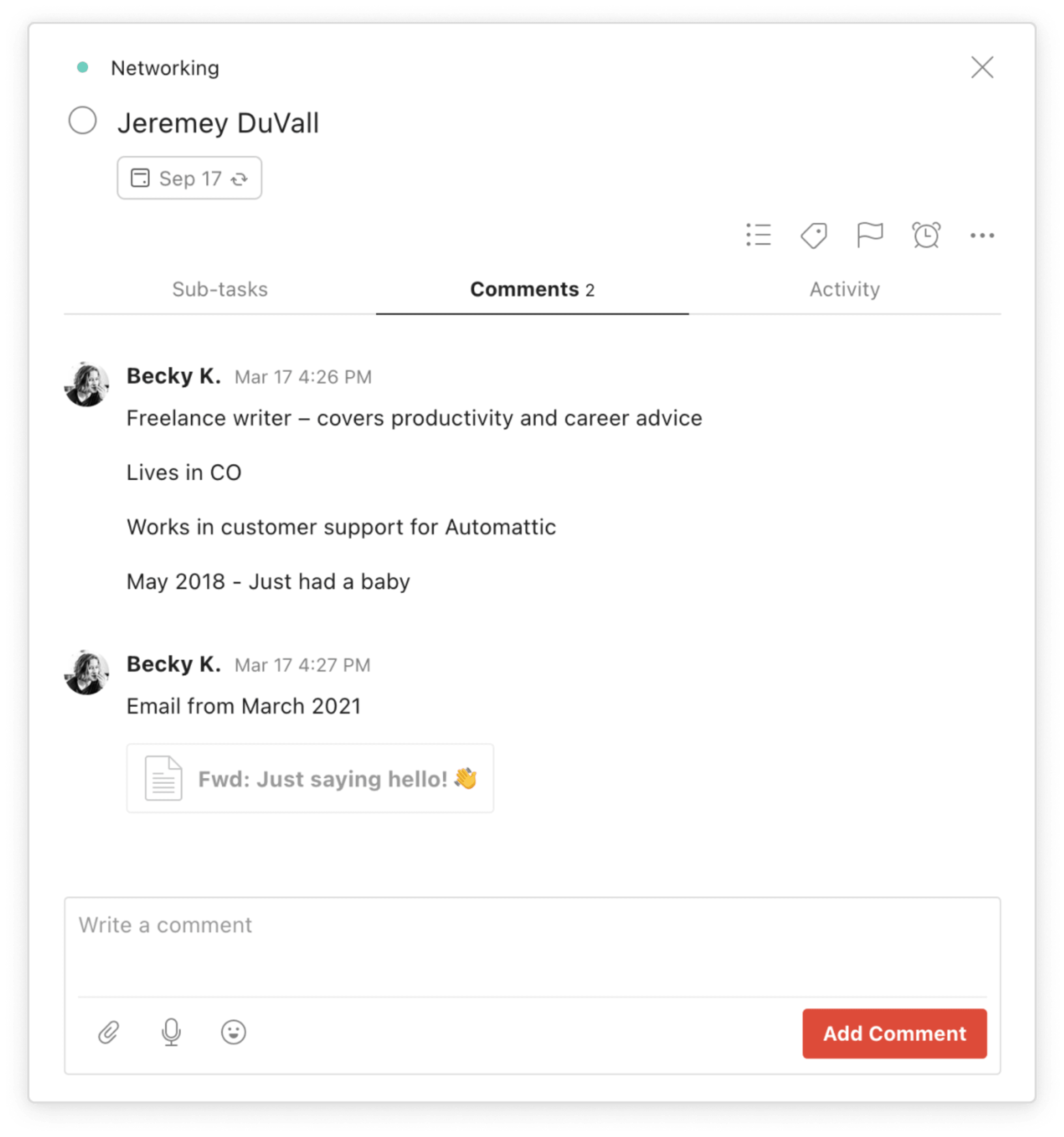
Use task comments to keep track of details you want to remember.[/caption]
- If you said you were going to follow up with something, add a task for it with a due date so you don’t forget. The bar is so low that simply doing what you said you were going to do already makes you stand out.
Keep an eye out for opportunities to pay it back and pay it forward
This goes back to the point about networking generously, but it’s so important to successful networking that it bears repeating. There’s no better way to keep a relationship warm than to connect the other person to an opportunity.
“I like to be generous and share the wealth,” says Laurel. “A rising tide raises all ships, right? Anytime that there is a speaking engagement, an opportunity for somebody to be quoted, an opportunity to speak on a panel, or whatever, I go to my list of people I want to stay in touch with.
Kat has had a similar experience as a freelancer: “I can’t overstate the benefit of building relationships with other freelancers. They not only provide advice and an outlet for venting, but we refer work to each other all the time.”
Whether it’s an introduction or a job opportunity, when you’re in a position to help someone out, don’t hesitate. Networking is a positive sum game. The more people you help out, the more people there will be who are looking out for you.
Virtual networking doesn’t have to stay virtual
Take advantage of traveling to meet people you’ve met online in person. Grabbing a cup of coffee in real life is a great way to strengthen the connections you’ve built online. And as an added benefit, they’ll probably have great recommendations for things to do and restaurants to eat at while you’re in town.
Meeting people in person isn’t necessary for building your network, but it is a nice bonus when it works out.
If all this seems like a lot of work, it is. You can’t automate or shortcut human relationships. It takes patience and empathy and a sincere desire to connect with people, not (just) because they can do something for you, but because you want to help others too. That’s why those who put in the time and effort to do it well stand out:
“Networking takes a lot of time and a lot of intention, and I think I was one of the only people to actually do that and to carve out that time,” says Laurel. That's how I became the person in my circles who everyone knows. I made time to make genuine relationships. That’s what it boils down to.”


